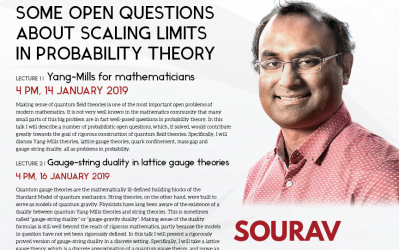Lecture 1: Yang-Mills for mathematicians
Date & Time: Monday, 14 January 2019, 16:00
Abstract: Making sense of quantum field theories is one of the most important open problems of modern mathematics. It is not very well known in the mathematics community that many small parts of this big problem are in fact well-posed questions in probability theory. In this talk I will describe a number of probabilistic open questions, which, if solved, would contribute greatly towards the goal of rigorous construction of quantum field theories. Specifically, I will discuss Yang-Mills theories, lattice gauge theories, quark confinement, mass gap and gauge-string duality, all as problems in probability.
Lecture 2: Gauge-string duality in lattice gauge theories
Date & Time: Wednesday, 16 January 2019, 16:00
Abstract: Quantum gauge theories are the mathematically ill-defined building blocks of the Standard Model of quantum mechanics. String theories, on the other hand, were built to serve as models of quantum gravity. Physicists have long been aware of the existence of a duality between quantum Yang-Mills theories and string theories. This is sometimes called “gauge-string duality” or “gauge-gravity duality”. Making sense of the duality formulas is still well beyond the reach of rigorous mathematics, partly because the models in question have not yet been rigorously defined. In this talk I will present a rigorously proved version of gauge-string duality in a discrete setting. Specifically, I will take a lattice gauge theory, which is a discrete approximation of a quantum gauge theory, and prove an explicit duality with a kind of string theory on the lattice. The duality has the appearance of a natural discrete analog of the formulas conjectured for the continuum models. The question of proving a continuum version of this duality remains open. These and other open questions will be discussed. (Partly based on joint work with Jafar Jafarov.)
Lecture 3: Constructing a solution of the 2D Kardar-Parisi-Zhang equation
Date & Time: Friday, 18 January 2019, 13:45
Abstract: The Kardar-Parisi-Zhang (KPZ) equation has become accepted as the canonical model for the growth of random surfaces. While the 1D KPZ equation has now a vast amount of rigorous mathematical work behind it, the physically important case of 2D surfaces has remained mathematically intractable. I will describe a first step towards constructing a solution of the 2D KPZ equation, by showing the existence of certain subsequential scaling limits if the parameters of the equation are renormalized in a suitable way. Many open questions remain, and these will be discussed. (Based on recent joint work with Alex Dunlap.)


